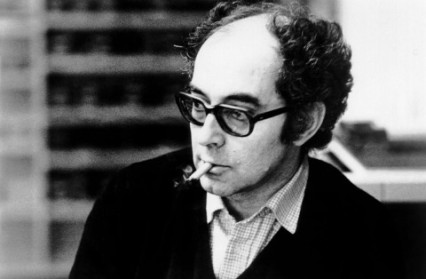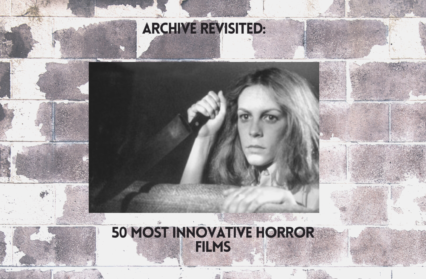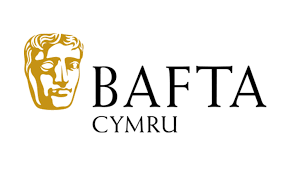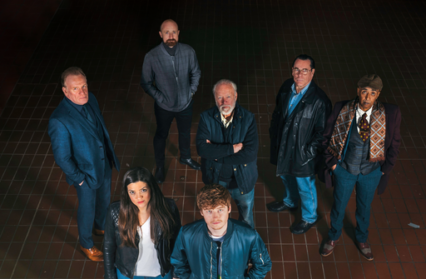Jean-Luc Godard and the Cinema of Reality – Paul Chambers looks at the impact and influence of the seminal director’s work.
As part of the BFI’s major Jean-Luc Godard retrospective, Chapter Arts Centre is screening three of the seminal director’s greatest early works this month: A Boute de Souffle (1959), Le Mépris (1963), and Alphaville (1965). Godard’s career has spanned six decades and, if his recent foray into 3D cinema is anything to go by, his creative, experimental flame shows no sign of dimming. From his ground-breaking work as a pioneer of the French New Wave in the late 1950s and early 1960s, through his television work in the 1970s and his video essay experiments in the 1980s and 1990s, Godard has remained a cinematic icon, a figure that both provokes and inspires.
Godard’s career in film, as it did for most of the hungry, young New Wave directors, began as a critic for the pioneering film journal, Cahiers du Cinema. Their vision and philosophy of cinema was inspired by the great critic and co-founder of the journal, Andre Bazin. Considering Bazin’s claim that ‘there is not one, but several realisms… each era looks for its own… the technique and the aesthetic that can best capture it,’ helps shape an understanding of the revolutionary artistic fervour that was being whipped up in these passionate, independent spirits in mid-1950s Paris.
In technical terms, the advances in film technology helped the New Wave directors capture these realities. The ready availability and relatively low cost of shooting on 16mm film with portable, lightweight equipment meant that contemporary film crews were liberated from the restrictive studio system. This allowed filmmakers like Godard to portray the locations, stories and characters that were most profoundly relevant to them. Suddenly, we were taken outside of the tourist city and into the gritty, urban outskirts of Paris. The lighting set-ups changed from glossy studio effects to what Godard’s cinematographer, Raoul Coutard called the ‘light of day’. The ability to record direct sound on location during filming (rather than relying on post-synchronisation) gave the works a more authentic, diegetic feel and, for Godard in particular, allowed for a far greater capacity for improvisation.
As can be seen in these early films, and in particular in his feature debut, A Boute de Souffle, this freedom gave the films a tangible, physical energy. This helped charge them with what Bazin describes as ‘an exceptional documentary quality that could not be removed from the script without thereby eliminating the whole social setting into which its roots are so deeply sunk.’
For Jean-Luc Godard and the pioneers of the New Wave, the world of film was a fresh and new reality, and the stories they told and the characters they portrayed needed to reflect this. The revolutionary techniques of the early 1950s literary movement of young French novelists, such as Alain Robbe-Grillet and Marguerite Duras (who also became filmmakers themselves, perhaps most notably in collaboration with Alain Resnais on Hiroshima, Mon Amour and Last Year in Marienbad) seemed to find new expression in the work of the New Wave directors, particularly in their approaches to plot, structure and character within the frameworks of their creative language.
The works were aimed at new, young, and impatient audiences, and the artists sought to incorporate contemporary events and realism into their fiction while avoiding classical, stylised and academic narration. In many of Jean-Luc Godard’s films, the influence of Existentialism resonates deeply in matters of character and narrative structure (particularly in regards to the traditional plot concept of ‘the hero’s journey’). A character such as Michel Poiccard (Jean-Paul Belmondo) in A Boute de Souffle seems to posses no clear desires or character goals, and often engages in seemingly irrelevant dialogue and actions to the film’s narrative. Godard’s existential approach, which allows his characters to explore and interact with their environment with no obvious desire or motivation bestowed upon them through plot detail (by a scriptwriter), provides a sense of reality that is the equivalent of the everyday environment of the cinema spectator. The lack of judgement or sympathy shown by Godard towards the majority of these characters allow us to engage in a dialect in which the motives of all the protagonist’s acts are questioned in relation to our own ideologies. This creates a reality for an audience in which we are never far removed from the reality of the character in the film.
The approach to narrative is perhaps what sets Jean-Luc Godard most distinctly apart from the other directors of the New Wave. In his pioneering essay, The Birth of a New Avant Garde; Le Camera Stylo, Alexandre Astruc prophesised that the new cinema would ‘break free…from the immediate and concrete demands of the narrative, to become a means of writing just as flexible and subtle as written language.’ Compared to the more classical narrative techniques of directors such as Truffaut and Chabrol, Godard’s fragmented and increasingly elliptical and collage-like storytelling devices serve as a paradox.
His approaches to narrative technique appear to draw more from the theories of Bertold Brecht than they do from anything championed by Bazin in the films of Renoir or Orson Welles. In Godard’s films the idea of the classical narrative is countered by a narrative that becomes self-reflexive. There is a sense that a viewer finds true reality from the form of the fact and not from its content. Godard constantly reminds us that we are watching a filmed reality, and highlights the process of the apparatus of cinema itself.
In the opening moments of Le Mepris, we watch the process of the filming of a tracking shot in a sunlit studio lot, whilst Godard’s voiceover narrates the credits. If we were in any doubt, everything in this first minute reminds that we are experiencing a film. And, deeper than that, we are encouraged to look and engage critically at all of the techniques, devices and principles that we have so far taken for granted. The effect of this is that we question the established codes of film language and enter into a dialect with the film itself – as a form of constructed reality.
In a film such as Alphaville, Jean-Luc Godard plays with a host of film genres including the political thriller and the film noir in order to present a confusing and often disorientating muddle of political and philosophical ideas. The result is a deeply affecting example of Brecht’s desire to create a dialect in the spectator who is constantly questioning the constructed reality of the art form, in relation to his own political, social and philosophical ideologies.
Viewing these early works again, it is the drama of engaging with familiar locations, attitudes, situations, techniques, and even familiar selves, in fresh, strange and self-reflective perspectives that seems to me the most striking note of Jean-Luc Godard’s cinematic experience. His belief that ‘you don’t make a movie, the movie makes you’, feels just as apt an expression for the experience of his film’s spectators as it does for their director. Although these films were released almost 60 years ago, there is a freshness of style, of energy, of challenge, that resonates just as strongly, perhaps even more strongly, than they did when they were first released. I would urge anyone not familiar with his films, and even those who are, to go and see them in the cinema, in their natural arena, and experience for themselves the once-in-a-generation energy that arises at the birth and the blossom of a true cinematic maverick and poet.
Cinema of Reality
The three films in Chapter’s Jean-Luc Godard season are A Boute de Souffle (1959), Le Mépris (1963), and Alphaville (1965). Tickets can be purchased online at www.chapter.org
Cinema of Reality












